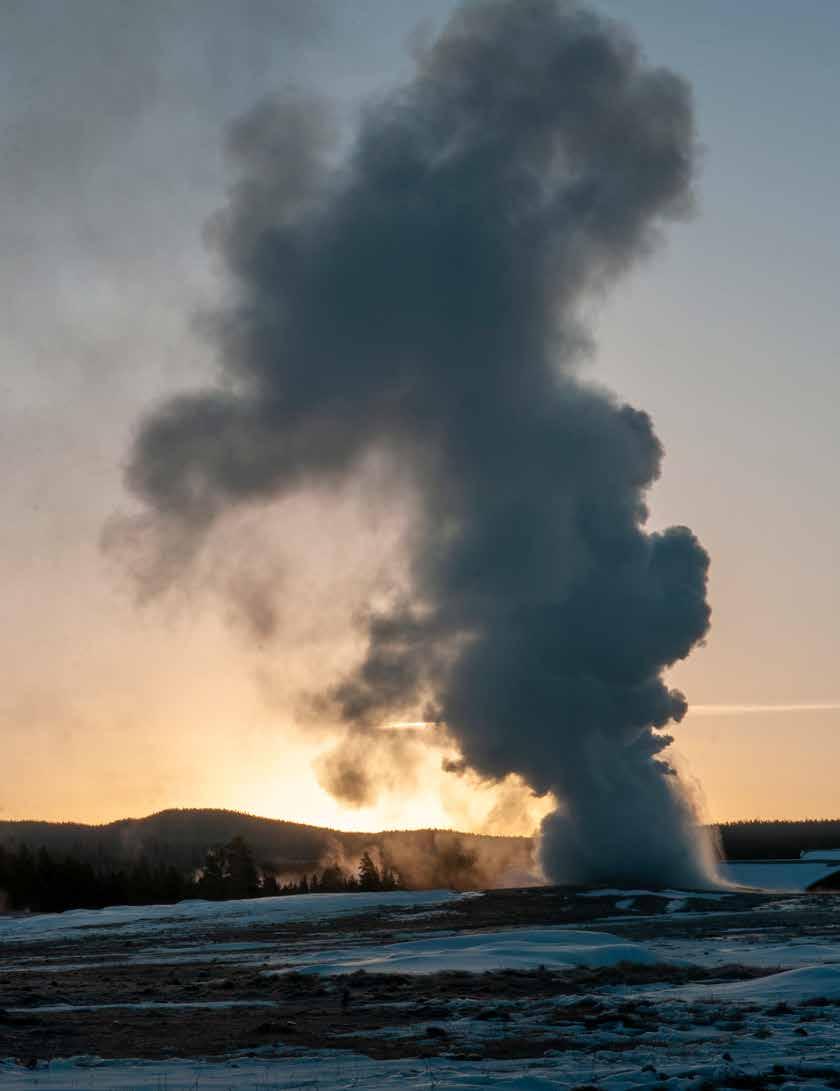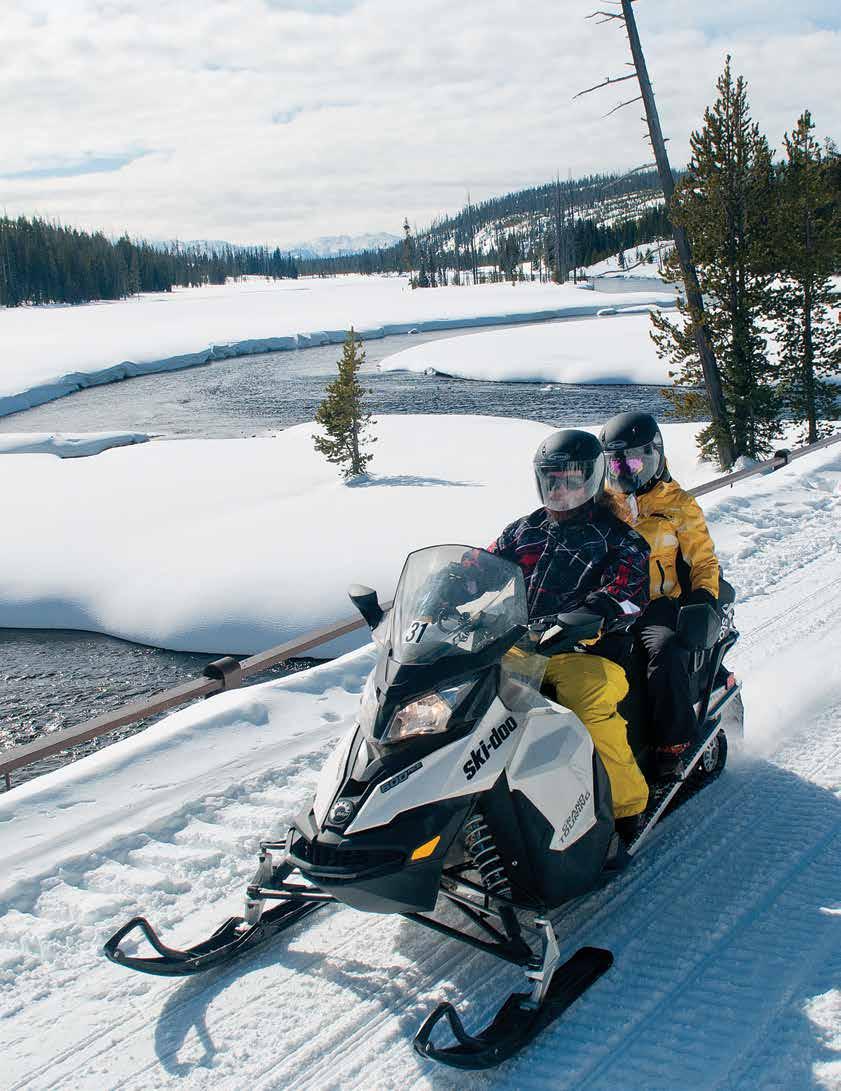
9 minute read
GETTING OUT
Best of JH
Winter Wonderland
Advertisement
Snowmobiling is an easy way to see winter in Yellowstone. No experience necessary.
THE EARLY MORNING light crests the eastern tree line in Yellowstone National Park, transforming the snow-covered ground into a sea of sparkles. The park’s main thoroughfare from the south parallels the Lewis River, which seems to keep pace with our snowmobiles. From early November through May, Yellowstone’s roads close to regular traffic with the exception of a road between Mammoth Hot Springs and the community of Cooke City, Montana, just outside of Yellowstone’s northeast entrance. Snow accumulates on the 100-plus miles of closed roads, and, beginning December 15, the park grooms them, allowing snowmobiles and snow coaches (tour buses with giant snow tires or tracks for wheels) to bring visitors into a winter wonderland.
Our snowmobile tour began in a minibus in the 6 a.m. darkness of Jackson. The guide, Bri Rambles, was bright-eyed and smiling while we passengers struggled with drooping eyelids. Now, ninety minutes north of town, the minibus sputters to a stop at Flagg Ranch’s Headwaters Lodge in the John D. Rockefeller, Jr. Memorial Parkway, a strip of land between Grand Teton and Yellowstone National Parks. We’re here to snowmobile in the latter, but first comes breakfast—and wiggling into puffy snowmobile gear.
Rows of frosty snowmobiles await us outside while we stuff our stomachs at the breakfast buffet inside the lodge. In the “boot and suit” room, Rambles’s role is that of a tailor as she fits each of us into insulated boots and one-piece suits. Once we’re kitted out, we head outside and begin testing our borrowed clothing and boots’ ability to withstand Wyoming’s freezing winter temperatures. Mostly warm, we wait for instruction on how to operate a snowmobile. (Prior snowmobiling experience is not a requirement for the tour.)
Our driver’s education, snowmobile edition, includes cautionary tales that toe the line between seriousness and humor, including: Gently squeeze the throttle to avoid landing yourself in a tree; and keep an eye on the brake lights of the snowmobile in front of you. And then we’re off in a slow-moving, single file line as drivers get acquainted with their throttles and brakes. THE SUN RISES quickly, but the temperature does not. Our first stretch is short; less than a couple of miles from the lodge, we stop for a photo at the Yellowstone National Park sign. We don’t know it at the time, but this is the least interesting stop of the day.
Communication is difficult under heavy full-face snowmobile helmets, so Rambles has taught us a repertoire of hand signals. A raised hand means “stop,” and, after we’ve officially ridden into the park, she raises hers at an overlook. When we’ve all demonstrated our mastery of this hand signal by stopping, we turn off our machines and Rambles regales us with the history of the surrounding sights, including that of Lewis Canyon, through which runs the Lewis River. A tributary of the Snake River, the Lewis River was named for Meriwether Lewis, of Lewis and Clark fame, despite the fact that neither his famous expedition nor Lewis himself ever set foot in Yellowstone. Brown, brook, and cutthroat trout live in the river all year. After the Lewis River, there’s Lewis Falls and Lewis Lake.
Up the road, a mass of parked snow coaches indicates wildlife activity. We don’t know what it is the snow coachers see, but we turn off our machines and walk up the road in their direction. There’s a wolf pack in the trees. The Lamar Valley, in the northern part of the park, is Yellowstone’s most famous wolf-watching spot, yet, here in the southeast, we catch a fleeting glimpse of dark-bodied canines trotting
Commercial outfitters do day-long snowmobiling trips into Yellowstone daily from mid-December until mid-March (weather permitting).
through the trees. We count more than one dozen—a big pack. Old Faithful is supposed to be the trip’s highlight, but seeing wolves in the wild is amazing.


IN THE SUMMER, each eruption of Old Faithful can draw more than 2,000 spectators. When we get to the world’s most famous geyser, only a few dozen people stand on the boardwalk that surrounds it. (Winter in Yellowstone sees about one tenth the number of visitors the rest of the year does.) The geyser, the tallest of the six in the park whose eruptions can be predicted, soon sputters to life, a plume of water and steam shooting high above our heads for a couple of minutes. When the eruption is over, we return to wildlife watching. Around the geyser basin, the dark behemoth bodies of bison move slowly, grazing on grasses kept snow free by

RYAN JONES
Usually you can see dynamic exhibits about Yellowstone’s hydrothermal features at the Old Faithful Visitor Education Center, but it is closed this winter because of Covid-19. The park’s app, NPS Yellowstone, shares similar information and predictions of when the park’s geysers might erupt.
Going Solo

Between 1963 and 2004, unguided snowmobiles were permitted to tour the park, but the noise and air pollution they caused—and because some drivers harassed park wildlife— caused Yellowstone to close to private snowmobiles. This was revised in 2014, when the Non-Commercially Guided Snowmobile Access Plan was released. It allows one non-commercially guided (i.e. private) group a day to enter at each of the park’s over-snow entrances: the North Entrance, East Entrance, South Entrance, and West Entrance. Permits are $40 per day for a group of up to five snowmobiles, with an additional $6 application fee. Permits are available via a lottery system. Applications are accepted during the month of August, and lottery winners are notified by mid-September. Permits not claimed in the lottery are available on a first-come-first-served basis starting October 1. Only those snowmobiles registered with the NPS and certified as meeting requirements for new best available technology (BAT) are allowed inside Yellowstone. Four Jackson-based companies rent BAT snowmobiles: Jackson Hole Adventure Rentals, Leisure Sports, Old Faithful Snowmobile Tours, and Scenic Safaris. Apply for a lottery permit or firstcome-first-served permit at recreation.gov.
RYAN JONES
Bison graze near Yellowstone’s Madison River.

the heated ground. Steam plumes from their nostrils with each exhalation, while geyser overspray has coated the backs of some in shimmering ice crystals.
We go into the Old Faithful Snow Lodge to warm up and enjoy another buffet; this time it’s lunch (baked ziti or wild game chili, with a vegetarian option). Stuffed and warm, we form a caterpillar line of snowmobiles to start the trek back to Flagg Ranch. We follow the morning’s route but stop at sights we skipped on the journey in, including the Kepler Cascades and multiple crossings of the Continental Divide, the hydrological divide that runs from Alaska through western Canada along the crest of the Rocky Mountains to New Mexico and beyond. (The road crisscrosses this ridge several times between Old Faithful and Flagg Ranch.) The Kepler Cascades are on the Firehole River and drop about 150 feet over the course of their three tiers. The tallest tier is about 50 feet.
At the Yellowstone Lake Overlook, we take in the largest high-altitude lake in North America. Yellowstone Lake’s surface area is about twice the size of Washington, D.C. The part of the lake we can see is frozen, but it does sit atop the southeastern edge of the Yellowstone supervolcano’s caldera. There are underwater geysers, hot springs, and fumaroles that prevent some areas from freezing.
From its geological features to the roaming wildlife, Yellowstone’s ecosystem is a privilege to be immersed in on a quiet winter day. This is felt during the day. As Flagg Ranch grows smaller in the minibus’s side mirrors on the trip back to Jackson, the once-in-a-lifetime weight of the experience settles
Offered for Sale
Excellent business opportunity or Elite private ownership:

BRADLY J. BONER
Sister Bus S/N 17 from 1998

in even more completely. Knowing the impact we can have on Yellowstone’s land and wildlife, especially during the summer months when the roads are cluttered with crowds, I rest easy knowing that, by spring, the tracks we laid today will have melted away. With the wolves as our only witness, it’s like we were never there. JH
NUTS & BOLTS
Check to see how Covid-19 has affected Yellowstone and the outfitters mentioned below. Yellowstone’s winter season is December 15–March 15. Scenic Safaris and Old Faithful Snowmobile Tours both offer single-day Yellowstone snowmobile tours. These include transportation between Jackson and Headwaters Lodge (and back), a guide, breakfast, lunch, a snowmobile, boots, and a snowmobile suit. Scenic Safaris’ Old Faithful Snowmobile Tour and Grand Canyon of Yellowstone Tour start at $280/driver; $175/passenger; 307/734-8898; scenic-safaris.com. Old Faithful Snowmobile Tours’ Yellowstone Snowmobiling Day Tour starts at $350/driver; $175/passenger; 307/733-9767; snowmobilingtours.com.
1932 White Model 65 National Park open air
tour bus. Originally delivered to the Black Hills Scenic Tour Company - Custer State Park in 1932. Believed to be the only known remaining example of the classic 1932 Model 65 and appears to be Serial # 14 out of 22. It is a sister to the original fleet of Red and Yellow tour buses that traveled the roads of Glacier, Yellowstone, Grand Canyon, and Yosemite National Parks beginning in the late 1920’s. Complete photographic documentation of the restoration and provenance documents dating back to 1932 are included. This bus initially traveled the roads of the Black Hills, then four other National Parks from the 1930’s thru the 1960’s being retired in the early 1970’s after duty in Yosemite National Park. It sat in an old barn at a northern California cattle ranch, awaiting restoration beginning in 1998. Restored over a 5 year period by award winning craftsmen in Oregon, it is now close to zero time on the Hobbs meter, ready for new life on the roads of Jackson Hole and the Grand Tetons National Park. Carrying 16+ people with the elegance, grace and nostalgia of a slower time in America, the early years of this nation’s new National Parks. Restored ground up, adopting new technologies, a reliable late model G.M. 7.4 litre high torque engine, Turbo-Hydromatic transmission and G.M. Saginaw easy power steering. All interior woodwork is solid oak and maple. Private individual owned - never used commercially after restoration. Not only a highly lucrative business opportunity, but impressive and fun to pick up clients and friends at the airport for private nostalgic chauffeured travel to your mountain home. – $190,000 or best offer.
Contact Us: NatParkBus@gmail.com or (817) 475-9419












